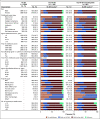Subsequent Neoplasm Risk Associated With Rare Variants in DNA Damage Response and Clinical Radiation Sensitivity Syndrome Genes in the Childhood Cancer Survivor Study
- PMID: 32923912
- PMCID: PMC7469586
- DOI: 10.1200/PO.20.00141
Subsequent Neoplasm Risk Associated With Rare Variants in DNA Damage Response and Clinical Radiation Sensitivity Syndrome Genes in the Childhood Cancer Survivor Study
Abstract
Purpose: Radiotherapy for childhood cancer is associated with elevated subsequent neoplasm (SN) risk, but the contribution of rare variants in DNA damage response and radiation sensitivity genes to SN risk is unknown.
Patients and methods: We conducted whole-exome sequencing in a cohort of childhood cancer survivors originally diagnosed during 1970 to 1986 (mean follow-up, 32.7 years), with reconstruction of doses to body regions from radiotherapy records. We identified patients who developed SN types previously reported to be related to radiotherapy (RT-SNs; eg, basal cell carcinoma [BCC], breast cancer, meningioma, thyroid cancer, sarcoma) and matched controls (sex, childhood cancer type/diagnosis, age, SN location, radiation dose, survival). Conditional logistic regression assessed SN risk associated with potentially protein-damaging rare variants (SnpEff, ClinVar) in 476 DNA damage response or radiation sensitivity genes with exact permutation-based P values using a Bonferroni-corrected significance threshold of P < 8.06 × 10-5.
Results: Among 5,105 childhood cancer survivors of European descent, 1,108 (21.7%) developed at least 1 RT-SN. Out-of-field RT-SN risk, excluding BCC, was associated with homologous recombination repair (HRR) gene variants (patient cases, 23.2%; controls, 10.8%; odds ratio [OR], 2.6; 95% CI, 1.7 to 3.9; P = 4.79 × 10-5), most notably but nonsignificantly for FANCM (patient cases, 4.0%; matched controls, 0.6%; P = 9.64 × 10-5). HRR variants were not associated with likely in/near-field RT-SNs, excluding BCC (patient cases, 12.7%; matched controls, 12.9%; P = .92). Irrespective of radiation dose, risk for RT-SNs was also associated with EXO1 variants (patient cases, 1.8%; controls, 0.4%; P = 3.31 × 10-5), another gene implicated in DNA double-strand break repair.
Conclusion: In this large-scale discovery study, we identified novel associations between RT-SN risk after childhood cancer and potentially protein-damaging rare variants in genes involved in DNA double-strand break repair, particularly HRR. With replication, these results could affect screening recommendations for childhood cancer survivors and risk-benefit assessments of treatment approaches.
© 2020 by American Society of Clinical Oncology.
Conflict of interest statement
The following represents disclosure information provided by authors of this manuscript. All relationships are considered compensated unless otherwise noted. Relationships are self-held unless noted. I = Immediate Family Member, Inst = My Institution. Relationships may not relate to the subject matter of this manuscript. For more information about ASCO's conflict of interest policy, please refer to www.asco.org/rwc or ascopubs.org/po/authors/author-center. Open Payments is a public database containing information reported by companies about payments made to US-licensed physicians (Open Payments). Belynda D. HicksEmployment: United Therapeutics (I) Stock and Other Ownership Interests: United Therapeutics (I) Honoraria: Roche Molecular Diagnostics Travel, Accommodations, Expenses: Roche Molecular Diagnostics, United Therapeutics (I)Susan A. SmithHonoraria: Memorial Sloan-Kettering Cancer Center Travel, Accommodations, Expenses: Memorial Sloan-Kettering Cancer CenterDiana M. MerinoTravel, Accommodations, Expenses: Aetion No other potential conflicts of interest were reported.
Figures



Similar articles
-
Comparison of Radiation Dose Reconstruction Methods to Investigate Late Adverse Effects of Radiotherapy for Childhood Cancer: A Report from the Childhood Cancer Survivor Study.Radiat Res. 2020 Feb;193(2):95-106. doi: 10.1667/RR15308.1. Epub 2019 Dec 3. Radiat Res. 2020. PMID: 31794291 Free PMC article.
-
Second neoplasms in survivors of childhood cancer: findings from the Childhood Cancer Survivor Study cohort.J Clin Oncol. 2009 May 10;27(14):2356-62. doi: 10.1200/JCO.2008.21.1920. Epub 2009 Mar 2. J Clin Oncol. 2009. PMID: 19255307 Free PMC article. Review.
-
Risk of Subsequent Neoplasms in Childhood Cancer Survivors After Radiation Therapy: A PENTEC Comprehensive Review.Int J Radiat Oncol Biol Phys. 2024 Jun 1;119(2):640-654. doi: 10.1016/j.ijrobp.2023.07.025. Epub 2023 Sep 29. Int J Radiat Oncol Biol Phys. 2024. PMID: 37777927
-
Radiation-related risk of basal cell carcinoma: a report from the Childhood Cancer Survivor Study.J Natl Cancer Inst. 2012 Aug 22;104(16):1240-50. doi: 10.1093/jnci/djs298. Epub 2012 Jul 25. J Natl Cancer Inst. 2012. PMID: 22835387 Free PMC article.
-
Pathogenic Germline Mutations in DNA Repair Genes in Combination With Cancer Treatment Exposures and Risk of Subsequent Neoplasms Among Long-Term Survivors of Childhood Cancer.J Clin Oncol. 2020 Aug 20;38(24):2728-2740. doi: 10.1200/JCO.19.02760. Epub 2020 Jun 4. J Clin Oncol. 2020. PMID: 32496904 Free PMC article.
Cited by
-
Update on Recommendations for Cancer Screening and Surveillance in Children with Genomic Instability Disorders.Clin Cancer Res. 2024 Nov 15;30(22):5009-5020. doi: 10.1158/1078-0432.CCR-24-1098. Clin Cancer Res. 2024. PMID: 39264246 Free PMC article. Review.
-
Examination of Genetic Susceptibility in Radiation-Associated Meningioma.Radiat Res. 2022 Jul 1;198(1):81-88. doi: 10.1667/RADE-21-00035.1. Radiat Res. 2022. PMID: 35405740 Free PMC article.
-
Radiation-related genomic profile of papillary thyroid carcinoma after the Chernobyl accident.Science. 2021 May 14;372(6543):eabg2538. doi: 10.1126/science.abg2538. Epub 2021 Apr 22. Science. 2021. PMID: 33888599 Free PMC article.
-
Patient-Level DNA Damage Repair Pathway Profiles and Anti-Tumor Immunity for Gastric Cancer.Front Immunol. 2022 Jan 10;12:806324. doi: 10.3389/fimmu.2021.806324. eCollection 2021. Front Immunol. 2022. PMID: 35082793 Free PMC article.
-
Genome-Wide Signal Selection Analysis Revealing Genes Potentially Related to Sheep-Milk-Production Traits.Animals (Basel). 2023 May 16;13(10):1654. doi: 10.3390/ani13101654. Animals (Basel). 2023. PMID: 37238084 Free PMC article.
References
-
- Gröbner SN, Worst BC, Weischenfeldt J, et al: The landscape of genomic alterations across childhood cancers. Nature 555:321-327, 2018 [Erratum: Nature 559:E10, 2018] - PubMed
Grants and funding
LinkOut - more resources
Full Text Sources

